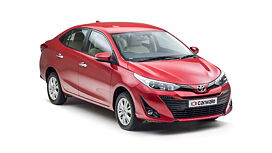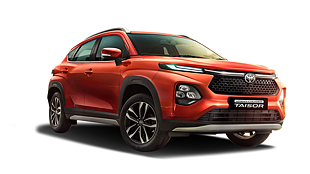Introduction

They may no longer be as affordable as they used to be, however, the C-segment sedans are still synonymous with aspiration and desire. They are a bona fide reflection of one’s success and achievement, especially for a compact car owner upgrading to one. For a few years now, the most sought-after choice has been the Honda City, the undisputed C-segment king. That said, if you are after refinement and cabin quality, you might be drawn to the Hyundai Verna or trust the Maruti Suzuki Ciaz for hassle-free ownership. Much of it comes down to perception and priorities although one thing is clear, as a complete family sedan, the current generation Honda City takes the cake.
Or does it? Because now there is some newfound opposition from what is perhaps the most dependable carmaker in business. Say hello to the Toyota Yaris, a car that has come knocking ot the door with segment-first features and a well-known nameplate. Having driven them back to back in a range of scenarios, the City and the Yaris tick all the right boxes but which of these two family-friendly offerings does the job better?

Inoffensive Looks

The Honda is off to a strong start here. Whichever way you look at it, the City wins convincingly when it comes to appearance and road presence. Despite being the older car of the two, it still looks fresh and up to date with today’s ever changing design standards. Right from the thick chrome grille, the all-LED headlights (which look smashing at night), those shiny razor cut alloy wheels and the boot lid spoiler; all contribute to give the City a strong road presence and a well-balanced look.

The Yaris, on the other hand, looks restrained but is easy on the eye nonetheless. The highlight, undoubtedly, is the front-end as there’s a lot going on – the slim projector headlamps are surprisingly aggressive looking, and so is the bumper design. Move onto the sides and the Yaris suddenly appears too plain. The 15-inch alloy wheels look basic and because of the smaller diameter, the Yaris ends up looking undertyred.

Fortunately, there are some nice elements around the back, namely the protruding taillights and the large bumper but overall, the Yaris’ design follows a safe, no-nonsense approach. On the road, it also appears much narrower compared to the City and that’s down to the lack of muscle on the sides and around the back. Round one, then, goes to the City simply by the virtue of its well-balanced design.

Cabin Comfort

The interior design of the Yaris isn’t special either though its ambience and plastics are superior to the Honda’s. The simple dashboard layout is a little grim and subdued next to the City’s dash which is funky with a flurry of asymmetric cues, but overall the black and beige cabin feels relatively airy and boasts of good quality plastics. The black-coloured steering wheel and the top half of the dash interplay with the silver trim pieces and the beige elements to create a sense of premium atmosphere. That said, the door panels, despite the soft touch arm rests, feel mediocre and a bit scratchy although that’s expected in this segment of cars.

The City has a bolder and subjectively, a cooler looking cabin. It, too, has shiny scratchy plastics with noticeable panels gaps – the panel right above the cup holders is shockingly flimsy and has a gap big enough to see through. As far as first impressions go, the City still has the edge thanks to the multilayer dash, soft padding on multiple touch points and the funky touch controls for the air-con.

In terms of comfort and convenience at the front, it’s the Yaris that comes out stronger in several areas. First up, the seats are set at a good height and are broad with more than enough lateral support. The backrest, too, is impressive and as we found out, more comfortable than the City which didn’t feel as supportive. The Honda also loses some points as we move onto frontal visibility – even though it’s got a large windscreen and side windows, the thick A-pillars the obstruct view quite a bit.

It’s a different story altogether as we move onto the rear. Here the City edges the Toyota for knee room and shoulder room – our measuring tape revealed that the Yaris is noticeably short on both counts. The rear windows are also smaller than the City and although you do get a completely flat floor, its benefit is futile as the front arm rest-cum-storage bin extends well behind the front seats and eats into the middle occupant’s knee room.

Now the Yaris may not match the City for sheer space but its rear bench is more supportive thanks to a well contoured back rest. In comparison, the City’s rear seat is a bit flat and the cushioning is harder, too. That said, the seat base is longer in the Honda and the back rest is perfectly angled, too, aiding to a more comfortable seating position.

Equipment List
In this segment, alloy wheels, climate control, steering mounted controls, height adjustable driver seat, electric mirrors and a multimedia system are standard fare. There are, however, many differences beyond these common features. First up, both these cars come with a 7-inch touchscreen display, however, the one in the Yaris is riddled with issues – not only does it look like an aftermarket unit, it’s also low on quality.

The display quality is right about average and so is the audio output from the 6-speaker system. What’s worse is that the whole thing rattles over bad roads and the noise is audible over the music most of the time. The 7-inch display on the City is comparatively better with a more refined UI and better touch sensitivity. The latter even comes with a 1.5GB internal storage.

As for the rest of the features, it’s a hit and miss affair for both. While the top-spec Yaris gets a lot of segment-first features including 60:40 split folding rear seats, electrically powered driver’s seat, roof-mounted air vents, rear disc brakes and front parking sensors, it misses out on a few essentials like one touch lane change indicator, telescopic steering adjust and auto dimming rear view mirror.

The best thing, however, is the fact that Toyota is offering 7 airbags and ABS as standard across the range which is really commendable. Honda, on the other hand, gets you 6 airbags in the top-spec variant of the City, however, the rest of the line-up gets only 2 airbags. The ZX variant, which is otherwise well specced with LED headlights, sunroof, leather seats and more, doesn’t get traction control, ESP or even rear parking sensors.

Driving Manners

On paper, the Yaris and the City are quite similar as both come with a petrol-automatic drivetrain including a seven-step CVT. Both the drivetrains have their own strengths and flaws. Starting with the newer car of the two, the Etios-based 1.5-litre motor in the Yaris makes 105bhp/140Nm and as one would expect, it’s pleasantly quiet at idle and even under normal driving, remains unobtrusive and refined. Honda’s 1.5-litre motor in the City makes more power at 119bhp but right about similar torque at 145Nm. Right from the word go, if feels perkier, moving this 1110kg sedan with ease. Be it coming out of a tight corner or driving up an incline, the more powerful City always felt punchier, however, there is a price to pay – the relatively old engine inhere is nowhere as refined as the Yaris. Speaking of which, the latter offers enough go for city driving and it does so with a less noisy engine but ultimately it’s a bit slow when you try to reel in that gap in traffic.

The City’s horsepower advantage meant it covered the 0-100kmph sprint in 11.74 seconds, as against the Yaris’ time of 13.84 seconds. That said, the newcomer just about managed to edge the City in-gear, with a 20-80kmph time of 8.21 seconds as against the City’s best time of 8.51 seconds. That’s because maximum torque in the Yaris comes in at 4,200rpm whereas the City’s engine ought to rev slightly higher for maximum punch.

As for the gearbox, we did notice that the CVT in the Yaris has less of the trademark rubber-band effect wherein there is an instant rise in engine revs in proportion to the gain in momentum. The City’s CVT, meanwhile, suffers heavily from this effect which makes driving in a hurry rather annoying. Like with most CVT-equipped cars, the Yaris and the City cruise at highway speeds with incredible ease but it’s the former that feels more relaxed thanks to a more refined engine, better insulation and less tyre noise. The City, on the other hand, is noisy at high speeds with more engine noise and tyre roar than we would like.

The way the Yaris deals with road imperfections and pot holes is quite impressive. At low speeds, it delivers a ride that’s absorbent without getting too soft. There’s also a good deal of suspension travel which means driving on bad roads isn’t that much of a task. Even at high speeds the Yaris remains planted over rippled, undulating surfaces. Around town, the City cannot match the compliance of the Yaris – it rides a little stiff and as a result sharp edged bumps make their way into the cabin with a loud thump. Things get better at highway speeds wherein the City remains thoroughly composed and delivers a smooth ride.

The City also takes the corners better than the Yaris, thanks to a more communicative steering, a well-balanced chassis and better front-end bite despite the lack of ESP or traction control. In comparison, the Yaris’ steering hardly has any feel and the whole car rolls noticeably more than the City.

Fuel Efficiency

It’s a close battle between these two in terms of fuel efficiency. Under our test cycle, the Yaris managed 11.6kmpl in the city and 15.9kmpl on the highway. The Honda, meanwhile, returned 11.4kmpl in the city and 16.2kmpl on the highway.
Verdict
2nd
Toyota Yaris VX AT
Price: Rs 16.77 lakhs on-road Mumbai

For someone upgrading from a premium hatch or a compact sedan, the Yaris makes a lot of sense. After all, it’s a Toyota and invariably it’s bound to be reliable in the long run. The Yaris is also extremely well equipped and comfortable with a splendid ride quality. However, it’s also retrograde with the way it looks and drives. The exterior design is restrained and while the interior is spacious and comfortable, it’s not the best looking cabin out there. Also, we cannot help but frown at the prices – at nearly Rs 17 lakhs it’s the most expensive petrol automatic C-segment offering and we are not sure if that’s exactly good value.
1st
Honda City ZX AT
Price: Rs 16.18 lakhs on-road Mumbai

The evergreen Honda City, then, may be relatively old and not as refined as the Yaris, but it’s a striking looking car, one with a lot of aspirational value. It’s also nicer looking on the inside, has all the modern tech and a spacious back seat. More importantly, it offers strong performance and is more likely to please those who love to drive as well as those who are simply looking for a big sedan for A to B runs. All in all, the City still feels a class above the Yaris and for that reason it remains the undisputed king of the C-segment.
Pictures by Kapil Angane
Click here for our first drive review of the Toyota Yaris
Click here for our first drive review of the Honda City
Specification
| CAR NAME | Toyota Yaris | Honda City |
| Variant | VX AT | ZX AT |
| ENGINE | ||
| Fuel | Petrol | Petrol |
| Installation | Front, transverse | Front, transverse |
| Displacement | 4 cyls, 1496cc | 4 cyls, 1497cc |
| Power | 105bhp at 6000rpm | 116bhp at 6600rpm |
| Torque | 140Nm at 4000rpm | 145Nm at 4600rpm |
| Power to weight | 92.92bhp per tonne | 104.5bhp per tonne |
| Torque to weight | 123.89Nm per tonne | 130.63Nm per tonne |
| Gearbox | 7-Step CVT | 7-Step CVT |
| CHASSIS & BODY | ||
| Kerb weight (measured) | 1130kg | 1110kg |
| Tyres | 185/60 R15 | 185/55 R16 |
| Spare | Full-size | Full-size |
| STEERING | ||
| Type | Rack and pinion | Rack and pinion |
| Type of assist | Electric | Electric |
| Turning circle |
5.1m |
5.3m |
| BRAKES | ||
| Front | Discs | Discs |
| Rear | Discs | Drum |
| Anti-lock | Yes | Yes |
Test Data
| CAR NAME | Toyota Yaris | Honda City |
| Variant | VX AT | ZX AT |
| PERFORMANCE & BRAKING | ||
| 0-20kmph | 1.84s | 1.40s |
| 0-40kmph | 4.17s | 3.42s |
| 0-60kmph | 6.62s | 5.65s |
| 0-80kmph | 9.72s | 8.38s |
| 0-100kmph | 13.84s | 11.74s |
| 0-120kmph | 19.36s | 16.34s |
| 20-80kmph | 7.88s | 8.17s |
| 40-100kmph | 9.77s | 9.65s |
| 80-0kmph | ||
| FUEL ECONOMY | ||
| City | 11.6kmpl | 11.4kmpl |
| Highway | 15.9kmpl | 16.2kmpl |
| Tank size | 42 litres | 40 litres |
| Range | 558km | 530km |
| INTERIOR MEASUREMENTS | ||
| Front | ||
| Legroom(Max/min) | 870/620mm | 830/700mm |
| Headroom | 980mm | 910mm |
| Shoulder room | 1330mm | 1320mm |
| Backrest height | 630mm | 550mm |
| Rear | ||
| Legroom(Max/min) | 860/630mm | 960/710mm |
| Ideal legroom | 730mm | 750mm |
| Headroom | 880mm | 920mm |
| Shoulder room | 1270mm | 1270mm |
| Seat base length | 480mm | 480mm |
| Backrest height | 640mm | 590mm |
| Boot | ||
| Length/width/height | 1020/1110/590mm | 830/1200/580mm |
| Loading lip height | 700mm | 760mm |


























